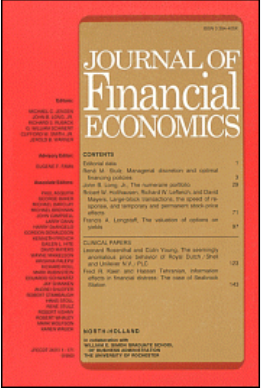创新与资本
IF 10.4
1区 经济学
Q1 BUSINESS, FINANCE
引用次数: 0
摘要
我们利用1980年大学创新商业化的制度变化,有力地增加了大学对专利和许可发现的激励,证明了可商业化创新供应的增加吸引了风险资本投资到该地区。Bayh-Dole法案将联邦政府资助的研究产生的知识产权所有权从联邦政府转移到大学,刺激了技术向当地的转移。由于大学具有不同的技术优势,1980年以后,大学周围的每个地方都经历了与特定产业相关的可商业化创新的增加,这在大学县之间差异很大。通过比较某县内与当地大学创新实力相关程度较高和较低的行业,我们发现,1980年后风险投资资金系统地流向受大学商业化创新突然涌入影响最大的地理区域和行业。即使在控制公司专利申请和先前风险融资的预先地理和行业分布时,这些结果仍然存在。研究结果支持这样一种观点,即增加可商业化创新的供应有助于吸引私人资本投资到一个地区。本文章由计算机程序翻译,如有差异,请以英文原文为准。
Innovation and capital
Using a regime change in the commercialization of university innovation in 1980 that strongly increased university incentives to patent and license discoveries, we document that an increase in the supply of commercializable innovation attracts venture capital investment to the region. The Bayh-Dole Act shifted ownership of intellectual property stemming from federally-funded research from the federal government to universities, spurring technology transfer into the local area. Because universities have different technological strengths, each local area surrounding a university experienced an increase after 1980 in commercializable innovation relevant to particular sets of industries which differed widely across university counties. Comparing industries within a county that were more versus less related to the local university's innovative strengths, we show that venture capital dollars after 1980 flowed systematically towards geographic areas and industries affected most by the sudden influx of commercializable innovation from universities. These results persist even when controlling for ex ante geographic and industry distributions of corporate patenting and prior venture financing. The findings support the notion that increased supply of commercializable innovation serves to draw private capital investment to a region.
求助全文
通过发布文献求助,成功后即可免费获取论文全文。
去求助
来源期刊

Journal of Financial Economics
Multiple-
CiteScore
15.80
自引率
4.50%
发文量
192
审稿时长
37 days
期刊介绍:
The Journal of Financial Economics provides a specialized forum for the publication of research in the area of financial economics and the theory of the firm, placing primary emphasis on the highest quality analytical, empirical, and clinical contributions in the following major areas: capital markets, financial institutions, corporate finance, corporate governance, and the economics of organizations.
 求助内容:
求助内容: 应助结果提醒方式:
应助结果提醒方式:


